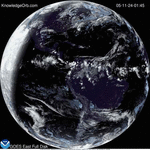
Beyond the Bubble: The general locations of Voyager 1 and 2 are shown in this illustration at the edge of the heliosphere, the bubble created by solar wind.
Image Credit: NASA/JPL-Caltech
It is official, NASA has announced that the Voyager 1 spacecraft, launched 36 years ago, has exited our solar system and entered interstellar space. KnowledgeOrb has been reporting on the progress of Voyager through the bubble of charged particles surrounding the sun that reaches far beyond the outer planets known as the heliosphere. Finally it has exited and entered into a new unexplored region. A report documenting this, an effort led by Don Gurnett and the plasma wave science team at the University of Iowa, Iowa City, is published in Thursday’s edition of the journal Science. The report confirms Voyager 1 has left the heliosphere. It is the first man-made object to do so and marks a milestone in our exploration of the universe. But what does this really mean to us? There are two parts to that question, one is technical the other is more philosophical.
Technical
Mankind has sent a device on a journey further than any other man-made object in history. This is an incredible technical achievement that not long ago was only dreamed of and written about in science fiction. This is all the more amazing when you remember that we are still in daily contact with the probe. It is in interstellar space and still functioning, sending science data home to Earth, responding to our commands. Every day it gets further away and deeper into space, into the unknown, We will learn from each new bit of data it sends back to us, Were in uncharted territory never before explored. Each and every day Voyager travels we learn something we did not know before.
“Now that we have new, key data, we believe this is mankind’s historic leap into interstellar space,” said Ed Stone, Voyager project scientist based at the California Institute of Technology, Pasadena. “The Voyager team needed time to analyze those observations and make sense of them. But we can now answer the question we’ve all been asking — ‘Are we there yet?’ Yes, we are.”
“We literally jumped out of our seats when we saw these oscillations in our data — they showed us the spacecraft was in an entirely new region, comparable to what was expected in interstellar space, and totally different than in the solar bubble,” Gurnett said. “Clearly we had passed through the heliopause, which is the long-hypothesized boundary between the solar plasma and the interstellar plasma.”
Philosophical
Man has entered into the unknown. Our drive to explore and learn has taken us to a place we have never been. While we still have issues here on planet Earth, war, hunger, economic problems, we can take some comfort in knowing that there is good in man and our desire to explore.
Voyager Spacecraft Close to Touching Face of God?
NASA expects the prove to continue to send data back until at least 2020. During this time we will learn more about deep space perhaps even enter an area which is totally undisturbed by the influence of Voyager’s home sun. While the probe is currently some 12 billion miles (19 billion kilometers) from our sun we will some day we will invent new technology that will catch and eventually pass this record-setting probe. But that will not be for some time to come. For most of us alive today Voyager 1 is our envoy to the universe. What we learn from it now will aid in future missions to deep space. Our children’s children will look back at our primitive little spacecraft and hopefully share and appreciate our desire to explore as they do so. Perhaps they will even see fit to retrieve Voyager and place it in a museum back here on our little blue marble.
While this probe was made by NASA and the United States it is actually an accomplishment by all of mankind. The records will show this event as the first time a man-made device entered interstellar space. We are all a part of history in the making. This is something we can all be proud to leave as our legacy, this is why we explore. There are many events which are negative and constantly reported in the news. It is times like this we remember there is good in the world, and there are good people on it.







